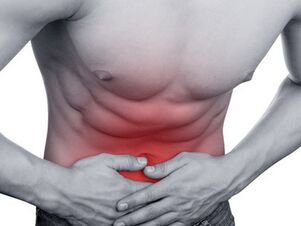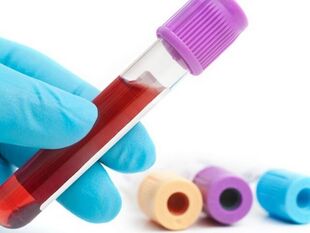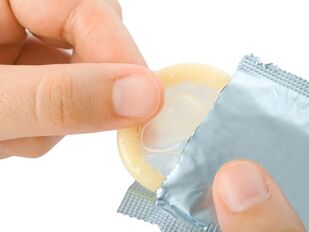Prostatitis refers to a purely male pathology of the urinary and reproductive systems. The disease can be acute or chronic, manifesting differently in each patient. Today, it is a common disease of the urogenital system. Currently, the disease has become much younger and already occurs in men over 25 years of age. In this article, we examine the question of how prostatitis manifests and its treatment.

Required Information
The nature of prostate dysfunction depends on a certain stage of male sexual development:
- Damage to the juvenile male prostate is possible. However, such a disease cannot be considered a separate disease due to the underdeveloped gland;
- Men who have a rough sex are more likely to develop prostatitis in the form of an acute inflammatory process; Adult male
- prostate disease manifests itself in one of three diseases: benign and malignant tumors, chronic prostatitis.
There is no prostate function in people who have undergone any type of reproductive organ removal.
The prostate is an accessory gland in the strong half of the reproductive device. It is located at the junction of the urinary and seminal tunnels. The importance of the prostate gland in adolescent men before puberty defied research. In an adult, the prostate is responsible for:
- is the formation of a secretion that makes the amniotic fluid less viscous and allows sperm to survive on the way to the egg;
- Prostaglandin production in the body. It is a component responsible for increased blood flow to the genitals before an erection develops. It also promotes the production of the hormone testosterone;
- is responsible for the high release of sperm during ejaculation and is also involved in the appearance of the last moment of sexual intercourse with the peak of intimate pleasure;
- reflexes do not allow urine to enter the sperm during intimate contact.
The prostate is a poorly protected organ for pathogenic microbes. It depends directly on the pathological condition of the pelvic organs. The high flow of blood and lymph that travels through the blood vessels of the damaged prostate is accompanied by the phenomenon of stagnation and edema, thereby exacerbating the inflammation. The gland contains a large number of nerve fibers, so the pathology manifests itself in pain.

Prostatitis is an inflammatory damage to the prostate. The most common cause of this disease is pelvic infection. But an infected infection alone cannot cause inflammation, which requires predisposing factors. It falls into this category:
- measured lifestyle (people doing sedentary work are at risk);
- regular stool retention;
- numerous hypothermia;
- too active intimacy and long abstinence;
The prostate is a small organ, weighing about 20-25 grams. But the secret of the gland is capable of destructively affecting microbes, so inflammation occurs in the prostate during stagnation, and then the secret loses its bactericidal properties.
Manifestations of prostatitis
The disease has two stages:
The acute form is manifested by the strongest inflammation of the prostate. The patient has a fever of up to 39 degrees, pain in the lumbar region, and in the process of excretion of feces and urine by the body. These are the first characteristic symptoms of prostatitis.
In a chronic course, these symptoms subside, so many men do not pay attention to the characteristic manifestations of the disease. The patient's temperature can rise up to 37 degrees, there can be painful feelings during dehydration and defecation. However, the main symptom of chronic prostatitis is the discharge of small amounts of mucous or purulent contents from the urethra.
Predisposing factors
There are 6 first symptoms of prostatitis - this is the failure of the deurination process due to the complicated urination of the bladder when the urethra is compressed by the enlarged prostate (dysuria syndrome):
- excretion of urine drop by drop;
- painful feelings;
- urine flow without pressure and up to 20 cm;
- radius interrupt;
- frequent dehydration at night;
- Feeling of incomplete emptying of the bladder.
Important! Diagnosis of prostatitis is prohibited if these symptoms are detected without a thorough examination. This disease has a very complex process of origin and development, involving various mechanisms.
Do not treat the disease solely on the basis of clinical manifestations. Contact a specialist immediately for an accurate diagnosis and prescribing therapeutic measures. Diagnosis and therapy are prescribed taking into account the organs and systems affected by the disease. In some cases, you may need to consult other professionals.
Signs of the disease
Prostatitis is an acute form of the inflammatory process and is chronic. The acute course is characterized by inflammation of the mucous membranes, follicles, and parenchyma, but should not be confused with symptoms of prostate adenoma. And it occurs with chronic - concomitant diseases.
Symptoms of prostatitis in men, identified by clinical and functional studies:
- Frequent urination
A normal man may want to be dehydrated up to 12 times a day, usually five times. The amount of urine in a healthy patient is 1-2 liters per day. The desire for dehydration occurs in a healthy person when the bladder is filled with a volume of 120-170 ml. Accumulation of more than 350 ml of urine triggers the strongest urge to urinate.

During the inflammatory process, the bladder walls are systematically irritated and dehydration:
- is not uncommon as long as the amount of urine is within normal limits;
- in small amounts: the products of the inflammatory process irritate the receptors of the bladder and there are false desires to dehydrate, the feeling of fullness of the bladder remains a feeling of fullness;
- painful due to narrowing of the urethra;
- difficult due to compression of the urethra by the gland, sometimes in its inability to empty the bladder when it is overcrowded;
- common at night;
- temperature.
Usually the temperature rises between 37 and 38 degrees. In the initial stage of sepsis with purulent inflammation of the gland, the temperature rises above 39 degrees. In the last stage of septic shock, on the contrary, the temperature drops to 35 degrees. Low temperatures pose a threat to human life due to platelet coagulation disorders. The outcome of prostatitis with sepsis complications is unfavorable.
- Blood in the urine
This is a fairly rare but dangerous sign of the course of the disease. Constant bleeding is almost impossible to stop. There are several reasons for the development of hematuria:
- with perforation of the vessel into the urethra;
- trauma in research;
- malignant hyperplasia;
- pain.
Inflammation of the prostate and related complications are associated with constant pain. It can rarely be intermittent. Most often, the pain is dull or aching in nature and manifests in the perineum and anus.
Laboratory Methods
Appointed to clarify the stage of the disease:
- Blood test. With the prostate, an increased leukocyte content is observed, an erythrocyte sedimentation rate is increased, and the leukocyte formula shifts to the prick cells;
- Urine analysis. It determines the purulent content of urine and the presence of bacteria. A three-bottle test is used: 3 doses of urine are taken at the beginning, middle, and end of the dehydration. Numerous urine tests reveal changes in the bacterial flora at intervals of several days;
- Bacteriological blood culture. It is prescribed to develop sepsis with 3-5 degree daily temperature fluctuations.

Instrumental research
- Ultrasound through the rectum. Clarifying the diagnosis is the most informative method. There are contraindications to this study.
- X-ray method. Contrast is injected into the bladder before the test.
- Excision of a piece of tissue can be used for microscopic examination in limited indications.
Causes of Prostatitis
Experts identify a number of classifications of why a man may have prostatitis:
- a complication of the symptoms of any disease that has affected the person before the woman, or the negative effects of gynecological diseases in the partner;
- urethral reflex. Failure of the prostate to function results in an inability to stop the return flow of urine. When this fluid enters the genital tract, it is called a urethral reflex. Bacterial seeding of the gland then develops. This disease is the result of inflammation of the urethra or improper insertion of the catheter. The lumen of the urethral canal also dilates;
- is an unusual way of living an intimate life. If a man has a significant increase or decrease in sexual intercourse, it can contribute to the development of prostatitis. The persistent delay in ejaculation is also a concern;
- venous blood plug in the genitals in the pelvic area. This happens in the absence of a sufficient number of active movements, sports;
- hormonal disorders caused by low hormone production in the gonads. Due to this pathology, general malaise of the skeleton and smooth muscles and other diseases occur.

Types of Prostatitis
There are two groups of this disease: bacterial and non-bacterial.
The first type is characterized by the disease being caused by the presence of pathogenic microbes that have entered the body from the external environment. Staphylococci, streptococci, Escherichia coli and many others fall into the category of harmful microorganisms. In addition, this classification of prostatitis also includes cases where the disease is caused by a disease transmitted through previous sexual contact.
For the second non-bacterial species, there are also several divisions:
- Congestive prostatitis. In this case, the disease of the gland is caused by congestion in the pelvic area. This result is usually caused by deficient ejaculation, excessive intimacy, long abstinence, and deficient sexual intercourse.
- Sclerotic prostatitis. It is characterized by a decrease in the size and function of the prostate. The tissue membrane thickens due to the destruction of prostate cells and degeneration into hard connective tissue. The causes of this type are frequent bowel movements, severe, slow bowel movements, taking certain medications, and a number of infections. This type of prostatitis is incurable.
- Calcular prostatitis. This type of inflammation reveals the presence of stones in the gland. Upon reaching large size, they cause severe pain in the urethra. Therapy consists of removing the stones by surgical or therapeutic methods.
- Prostatodynia. It is characterized by the presence of persistent pain in the pelvic area, the causes of which have not been studied. Presumably, it can be caused by backflow, disease of the neck of the bladder, damage to the muscle tissue between the anus and the genitals, and a psychological factor is also possible.
- Atypical prostatitis. The patient may complain of pain in the lower extremities, groin, and sacrum that is not present in typical forms of prostatitis. The outcome of therapy is directly related to the duration of the disease, the presence of complications, and the severity of the inflammatory process.

If treatment is started at the wrong time or the prostatitis gets worse again, the inflammation becomes severe, with serious complications: decreased potency, inability to conceive, depressive conditions, severe pain, prostate adenoma in men.
Complications
It all depends directly on age, immunity, bad habits and the timeliness of treatment. So excessive consumption of lower-immune, alcoholic products in complicated elderly people will have very serious consequences.
Action versus potency. The injured gland reduces the production of hormones that are responsible for the formation of erections. Complications include lack of completeness of feelings during intimacy, poor ejection of seminal fluid, signs of prostate adenoma in men, and impotence.
Effect on conceiving a child. Inflammation of the prostate greatly reduces the production of normal secretions in the female reproductive organs required for the activity of sperm for fertilization. The secret, getting into the girl’s birth canal during intimacy, goes through immune rejection, leading to the impossibility of fertilizing the egg.
Other complications. As prostatitis worsens, the risk of pus buildup in glandular tissues increases. The pain associated with prostatitis is increased. When a secondary infection is associated, the epithelium melts and a capsule near inflammation appears. In addition, the consequences include urinary retention, an acute manifestation of urolithiasis, and the appearance of prostate adenoma in men and others.
Intimacy with inflammation
The main causes of prostatitis have already been shown to be a lack of sexual intercourse with increased irritability or excessive sexual activity. Regular ejaculation with normal frequency has a beneficial effect in the early stages of prostatitis. Intimacy is temporarily prohibited during certain procedures and stages of the disease. More detailed information can be obtained in consultation with a specialist.
Important! You can make love when treating prostatitis, but only in terms of safety and moderation, unless your doctor tells you otherwise.
Prostatitis is a purely male disease. But inflammation of the gland poses a health risk to the partner. It poses a danger to the conception and carrying of the unborn child. A healthy lifestyle and reliable contraception are effective ways to protect your partners from complications.

Prostatitis Treatment
Complete recovery and further development of the disease can only be stopped by consulting a specialist in time. In this case, you will achieve a positive result. When irreversible changes appear, one cannot get rid of the disease completely. As a general rule, recurrent inflammation occurs with the transition to a chronic type.
In addition to medication, it is important to consider whether the patient is ready to make lifestyle changes (such as irregular intimate relationships or a sedentary lifestyle). If the patient does not want to change their normal lifestyle, the disease will soon reappear. Exactly with the fact that the patient does not want to change these negative factors and the concept is related to the fact that prostatitis cannot be treated.
The treatment options and their duration will be described by a specialist after a full examination and determination of the cause. The main drug used during treatment is antibiotics. Vitamins, physiotherapy, painkillers and anti-inflammatory drugs are also recommended. Exacerbation of prostatitis takes longer.
Diet
With a proper diet and the use of certain foods, you can achieve:
- reduces pain;
- improving blood and lymph movement in the prostate vessels;
- boost the immune system;
- normalization of intestinal function;
- Reduction of nocturnal urine output.
The following foods should be excluded from the diet:
- Coffee and spicy foods - increase prostate blood flow, increase pain.
- Fats, fatty meats, eggs, flour products - increase the formation of cholesterol plaques on the walls of blood vessels, reduce blood flow.
- Alcohol - lowers the body's immune system.
- Coarse fiber and salted foods violate the undulating contractions of the intestinal walls.
- Excessive fluid intake (especially in the evening) - increases the amount of fluid in the body, leading to bloating.
Recommended dishes: fresh vegetable salads with olive oil, fruits, cooked lean meats, vegetables, juices and nuts.

Prevention
Recommended for:
- wide promenade (physiological walk);
- rational nutrition;
- healthy lifestyle;
- use of male contraceptives;
- moderate intimacy and more.
Conclusion
You do not have to wait for any illness to appear, but you should see a doctor once a year for prevention. Treating secondary exacerbations of prostatitis is much more difficult and time consuming, and is fraught with its own complications.
In this article, we learned how inflammation of the prostate gland manifests itself and what the pains of prostatitis are, how to treat this disease.
























